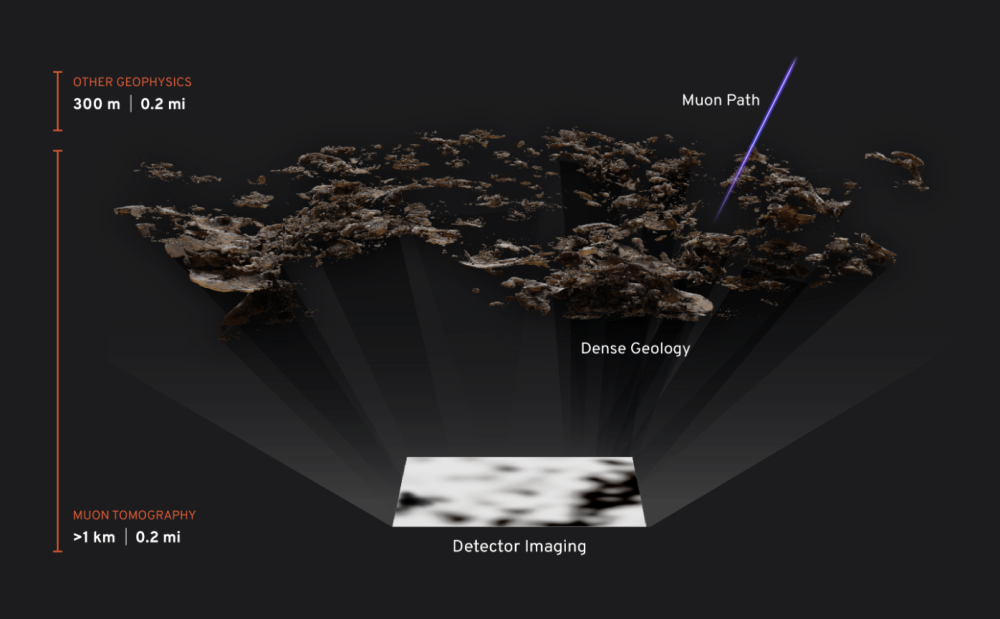Exploding stars send cosmic rays to Earth and now explorers are using them to see deep underground, reduce drilling, and uncover hidden mineral riches


, , , , , , , , ,
, , , , , ,
, , , , , , ,
In a world-first approach that sounds more like science fiction than geoscience, Ideon Technologies is leading a charge to reduce geological guesswork in mineral exploration using cosmic rays generated by exploding stars.
Speaking at Austmine’s Next-Gen Mining Exploration webinar, Kim Lawrence, Chief Experience Officer at Ideon, introduced muon tomography, a technique that uses naturally occurring subatomic particles to image what lies beneath the Earth’s surface. The result? An ultra-deep, high-resolution x-ray of the subsurface - one that could dramatically reduce drilling costs, accelerate discovery timelines, and lower environmental impact.
“What we’re really trying to do is address geological uncertainty,” Kim said. “It’s a challenge that affects all phases of the mining value chain, starting in exploration, and directly impacts the ability to make confident, well informed decisions throughout the life cycle of a mine.”

The deep challenge of uncertainty
Uncertainty in the subsurface is not just an inconvenience - it’s a primary driver of cost, risk, and delay across exploration and development. Traditional tools such as near-surface geophysics and drilling can only go so far in mapping the complex geology hidden below the surface. And while advances in AI and data analytics have helped make sense of this fragmented information, most exploration decisions are still based on incomplete and indirect data.
That’s where Ideon’s technology comes in. Rather than relying solely on extrapolation from sparse drill holes or 2D geophysical profiles, the company collects a new form of geophysical data based on cosmic ray muons - high-energy particles that rain down on Earth as a result of supernova explosions in space.
“Cosmic rays are constantly interacting with our atmosphere, creating showers of subatomic particles,” Kim explained. “One of those particles is the muon. They travel in straight lines at nearly the speed of light and can pass through hundreds of metres of rock. What’s unique about muons is that they lose energy at a rate that is directly proportional to the density of the material they pass through.”
By placing highly sensitive muon detectors underground - either down boreholes or in existing mine infrastructure - Ideon measures how many muons arrive from different directions and at what intensity. With this data, they generate detailed 2D radiographs of the subsurface, similar to x-rays in medical imaging. When multiple sensors are deployed around a target zone, those radiographs are stitched together into a 3D model of subsurface density, similar to a CAT scan.
“The analogy we like to use is a medical x-ray. Except instead of imaging a broken bone, we’re imaging millions of cubic metres of Earth - all completely non-invasively,” Kim said.

Seeing through rock
In practice, this means Ideon can detect and delineate areas of high-density (e.g. potential mineralisation) and low-density (e.g. voids or caves) at depths down to and exceeding one kilometre. This not only helps pinpoint drill targets more precisely but also provides critical geological context between and beyond existing drill holes - reducing the need for wide-spaced, exploratory drilling.
“You’re not drilling for discovery anymore, you’re drilling for validation,” Kim said. “We help you focus your efforts, so you can make faster, more confident decisions.”
One of the most striking examples Kim shared involved a deployment at Vale’s Creighton Mine in Sudbury, Canada - a site with over 100 years of mining history. Ideon deployed muon sensors in four drill holes over a six-month period and imaged a two-square-kilometre footprint around the mine. The insights gained were equivalent to 500 conventional drill holes and decades of exploration work.
“We were able to map areas of remnant mineralisation to within 10-metre spatial resolution - without disrupting operations,” she said. “We even imaged a historic sublevel cave and confirmed the connection between the open pit and the mine below.”
In another case, at Fireweed Metals’ Macmillan Pass Project in Yukon, Canada, Ideon deployed detectors at the start of the winter season and imaged the subsurface remotely through extreme conditions, reaching minus 50 degrees Celsius. The campaign delivered 3D insights equivalent to 50 drill holes - using only three holes - and identified several new targets that have since been validated.
And at the Caber Nord Project in Quebec, the Ideon team achieved their deepest deployment to date: one kilometre underground, imaging 450 million cubic metres from a single drillhole, achieving with 20-metre resolution. From just that one hole drilled into the Canadian Shield, the team identified previously unknown anomalies at 650 metres depth - offering new exploration leads on a project previously defined by 137 drill holes.
“These are practical, real-world results,” Kim said. “We’re not just reducing drilling - we’re radically improving the return on drilling by providing better targeting and more subsurface intelligence with less environmental impact.”
Scalable and field-proven
One of the key advantages of Ideon’s solution is its field adaptability. The detectors are borehole-deployable into HQ or PQ-sized drill holes and can operate autonomously in remote regions. Where there is no local power, they use mobile generators or renewable energy and transmit data to surface data hubs via satellite or cellular networks. From there, data is relayed to Ideon’s processing lab in Vancouver.
“We’ve operated everywhere from the deserts of Western Australia to the deep freeze of northern Canada,” Kim said. “All you see at the surface is a capped borehole and a data cable.”
For underground operations, Ideon also offers panel-format detectors that can be deployed in tunnels or development drives - ideal for block and sublevel caving environments. These panels image upwards, providing high-resolution mapping of the cave zone and surrounding rock mass.
“This kind of visibility helps with both safety and operational planning,” Kim said. “We’re helping teams visualise what’s happening inside the rock - not just where it’s fractured or mineralised, but how it evolves over time.”
A platform for subsurface intelligence
Ideon’s technology is deployed as part of its Reveal™ platform, which integrates muon tomography data with other geophysical, geological and geochemical datasets. The result is a unified 3D view of the subsurface that’s accessible to exploration geologists, resource modellers, and mine planners alike.
“Our subsurface intelligence platform that helps you quantify uncertainty, reduce risk, and make smarter decisions throughout the mine life cycle,” Kim said.
The Reveal™ platform also enables quantitative uncertainty analysis by highlighting zones where data coverage is sparse or ambiguous. According to Kim, this capability is particularly useful for exploration teams balancing limited budgets and compressed timelines.
“There’s always going to be some uncertainty in geology,” she acknowledged. “But understanding where that uncertainty lies - and how to reduce it - is how you gain a competitive edge.”
Looking ahead
Ideon’s approach is gaining traction globally, with deployments across Canada, the United States, Asia, and Australia. The company is also collaborating with major miners and METS partners to integrate its imaging capabilities into broader digital exploration workflows.
Kim remains optimistic about the impact this technology will have on how the industry approaches mineral discovery.
“Exploration has always been about informed risk-taking,” she said. “But with this kind of deep, high-resolution, real-time data, we’re shifting the balance - making decisions that are less about hope and more about evidence.”
As the mining sector continues to face pressure to discover new deposits, lower costs, and reduce environmental impact, solutions like muon tomography offer a way forward - illuminating the unseen and giving explorers a new lens through which to target the future.
“There’s a muon going through your head every second,” Kim added with a smile. “We’re just finding a way to use them for something remarkable.”
